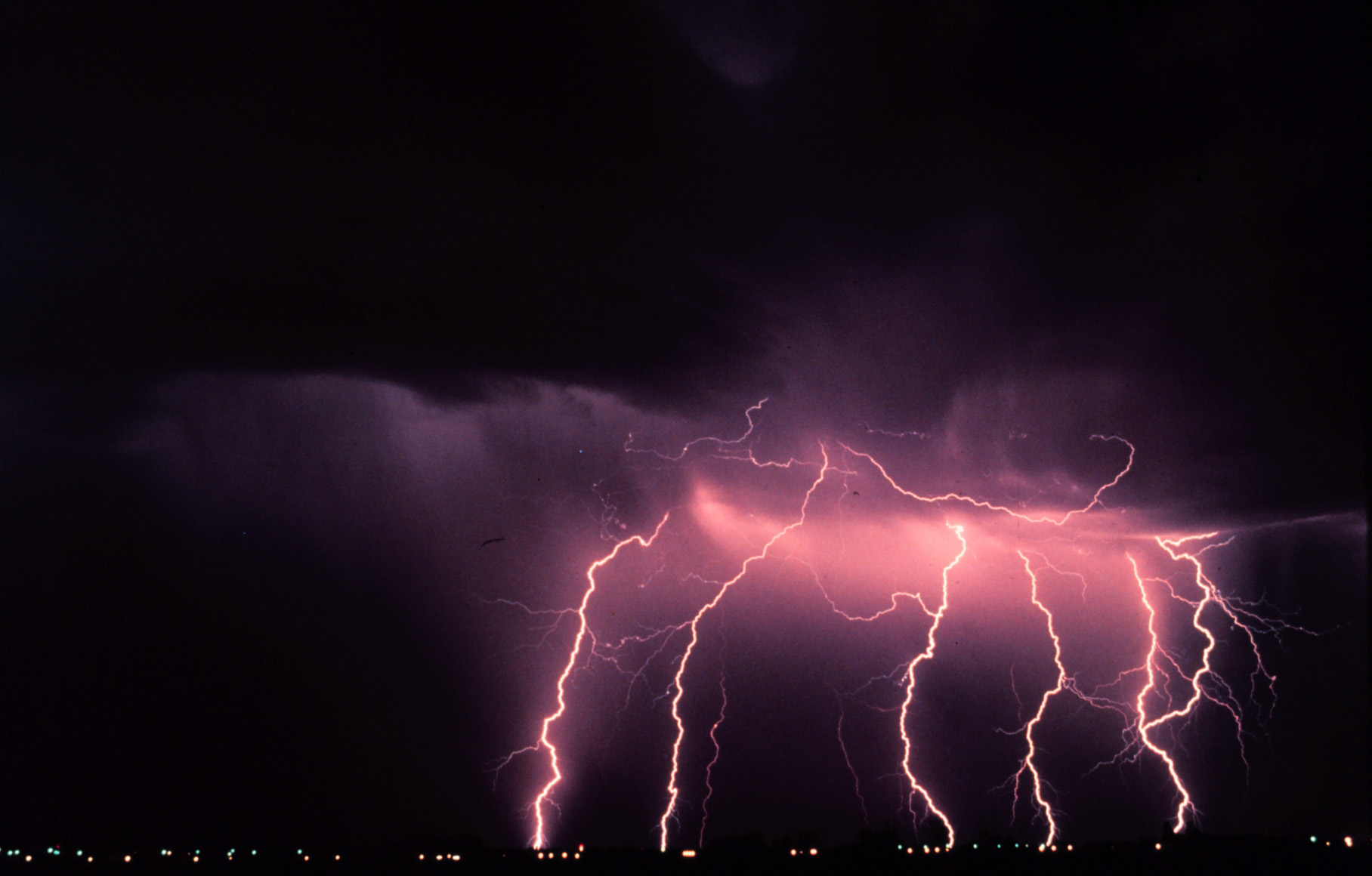| Name | Last modified | Size | Description | |
|---|---|---|---|---|
| Parent Directory | - | |||
| 150599main_lightning_photo.jpg | 2018-04-25 14:27 | 315K | ||
| ft.m | 2018-04-25 21:30 | 903 | ||
| invert_ft.m | 2018-04-25 21:30 | 547 | ||
| results-0.01s-cadence/ | 2018-04-25 21:30 | - | ||
| results-1s-cadence/ | 2018-04-25 21:30 | - | ||
| test1.m | 2018-04-25 21:30 | 657 | ||
| test2.m | 2018-04-25 21:30 | 1.8K | ||
| test_setup.m | 2018-04-25 21:30 | 1.5K | ||
This example concerns frame transfer CCDs, which are useful for moderately high speed imaging with very low readout noise. Here is a helpful summary of the relevant technology; and another good article on frame transfer cameras

Credit: NOAA Photo Library, NOAA Central Library; OAR/ERL/National Severe Storms Laboratory (NSSL).
Image smearing occurs as the charge is clocked across the face of a frame transfer CCD. The coordinates x,y on the CCD are measured in pixels. Assume, for simplicity, that the exposure begins simultaneously on all pixels at time t=0. The readout begins at time T. At that time, charge is clocked along the columns of a CCD, in the y-direction, at a rate f (rows per second, typically on the order of MHz), until the entire image is under the mask. The light sensitive part is on 0 < y ≤ N, and the masked area is N+1 ≤ y ≤ 2N.
My code for of the frame transfer smearing effect is in ft.m. I applied this code to a monochrome version of the above lightning image, in its native 2 megapixel (1816x1160) format, as an example. Unless we push the technology to video rates, the streaking effects tend to be subtle (but even subtle streaking is quantitatively important).
A simulated video rate image acquired by frame transfer. This is with 1000 mean counts per pixel. I assumed 38% smearing, which means that the readout (limited by ADC rate) takes 38% as long as the nominal exposure.
We want an inversion procedure that eliminates the charge smearing, recovering I from D. I worked out my solution not by staring at the integral equation (although that wouldn't be hard), but by visualizing the problem discretely in row-by-row steps as the image is clocked across the CCD. Notice that row N, immediately adjacent to the mask, suffers no smearing. Row N-1, in addition to the full exposure at its nominal location, is exposed to the same signal that was collected by row N for a duration 1 / f. This signal can simply be subtracted to recover the correct signal of row N-1. From there it is not hard to see how to extrapolate this procedure to subsequent rows.
Can the smearing be corrected in the presence of realistic noise? My inverse implementation is in invert_ft.m. Processing the above, noisy image produces the nicely corrected result below. The noise is exacerbated somewhat in the upper rows, which had the farthest to move before getting under the mask. Faster frame transfers (with lower smearing percentage) work best.
A reconstruction based on the previous image. The streaks are corrected. The noise is greater above the bright sources because of the Volterra form of the integral equation.
If you think about the transition from one exposure to the next, my assumption about the beginning of the exposure (simply turning on I(x,y) over the whole frame at time t=0) may be inaccurate. Because the previous expousre ended with a frame transffer, it is entirely possible that the streaks extend both above and below each bright feature. In that case, the integral equation is Fredholm rather than Volterra. Since the kernel is constant, the solution is trivial. Streak correction then only requires subtracting some constant coefficient times the column total from each column. If correct, this model is actually a better situation for the experimentalist: because the correction does not contain interline differences, it is less sensitive to noise.
The two integral equation models of the streaking effect, Fredholm and Volterra, could be readily distinguished experimentally in images of bright, high contrast sources. In the lab, the easiest procedure might be to operate in the dark at a warm enough temperature to have some hot pixels on the CCD. Each hot pixel is a continuous source of electrons (dark current, not photoelectrons). Observationally, streaking from a hot pixel is indistinguishable from the image of an idealized point source on the CCD.